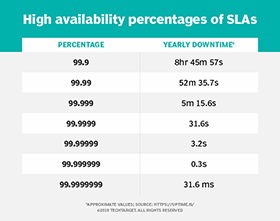
Mathias Rosenthal - Fotolia
Build a cloud resiliency strategy with these best practices
Implement these tips and strategies to minimize downtime and support resiliency in your cloud-based organization.
As the world continues to grapple with COVID-19, it's more important than ever for organizations to have robust, on-demand and scalable IT infrastructure that is always available, regardless of location.
Even under regular circumstances, IT downtime can prove to be costly. According to a study by Statista, the average hourly cost of server downtime was between $300,000 to $400,000. Given the constraints imposed by COVID-19, extended downtime can be catastrophic.
Organizations across the globe are quickly embracing cloud infrastructure and modernization to improve resiliency and uptime. An IDC study shows that more than 40% of enterprise customers in North America expect to significantly increase their spending on cloud in 2021. Gartner predicts that cloud is likely to account for 14.2% of the total global enterprise IT spending market in 2024, up from 9.1% in 2020.
Despite its many advantages, cloud infrastructure also comes with its own set of risks involving large-scale transaction volumes, open architecture and multiple vendors. Organizations need to address these risks with specific steps to build business resilience in a cloud environment.
Companies also need to prioritize modernization. A comprehensive modernization strategy helps streamline the provisioning and day-to-day management of a multi-cloud environment and enable innovation at scale using cloud capabilities.
Embrace the following best practices to a build a resilient cloud-based organization.
Remediate cloud-specific risks
Cloud deployments add greater complexity and volatility since they typically involve large-scale transaction volumes, open architecture and multiple vendors. Organizations also need to synchronize their cloud and legacy environments, as well as manage interdependencies. Cloud also requires greater dependency on network connectivity.

Therefore, building business resilience in a cloud environment requires some specific measures. The first is to build a comprehensive strategy that accounts for provisioning and day-to-day management of a multi-cloud environment, in addition to driving innovation using the cloud capabilities.
Assess downtime
Study the various types of workloads in your organization and determine the impact of downtime on these workloads. Then, consider how downtime affects business continuity. For example, any downtime on customer-facing applications, such as e-commerce applications, will directly impact the bottom line and also damage brand reputation. Therefore, organizations must work to ensure these applications are always running.
Additionally, legacy infrastructure often comes with issues such as single points of failure or end-of-support infrastructure. Organizations need to account for these issues to minimize downtime. It is also crucial that all the legacy systems are protected with the most up-to-date patches to ensure security.
Implement a strategy
Anticipating issues and planning for them in advance can help mitigate the negative impact of downtime. Consider putting a disaster recovery plan in place to ensure business continuity. Take a proactive approach to security through vulnerability assessment and penetration testing. These strategies help prevent security breaches from happening in the first place, rather than having to react when an attack occurs.
Take, for example, a company that requires 99.999% infrastructure uptime, which means a maximum estimated downtime of five minutes through the year. Ensuring this requires close coordination with the cloud provider to manage configuration, storage and other operational resilience parameters in great detail. It also means increasing security measures by applying the right patches and service packs, in addition to robust identity access management policies.

Even with the best of efforts, however, downtime can sometimes be inevitable. It's critical to have plans in place to help bounce back and recover as soon as possible.
Choose the right cloud provider
Each cloud provider comes with its own inherent strengths and weaknesses. It is important to choose a provider that is aligned closely with the nature of the organization's workload and applications. You can also opt for a multi-cloud approach that can handle disparate workloads if needed. Also, the right implementation partner not only helps make the right choice with respect to a cloud vendor, but also ensures consistent expedited support based on deep industry relationships.
The right IT infrastructure that can ensure everything runs smoothly and helps the business bounce back quickly in case of any unforeseen event is extremely critical for business continuity. Therefore, having a comprehensive plan in place to identify, foresee and address causes of downtime is an important part of building greater business resilience.
About the author
Anant R. Adya is the senior vice president and business head of cloud, infrastructure and security (CIS) services at Infosys. Adya is responsible for growth of the CIS service line in the Americas and Asia Pacific regions. In his 25 years of professional experience, he has worked closely with many global clients to help define and build their cloud and infrastructure strategies and run end-to-end IT operations. Currently, he works with customers and the industry sales/engagement teams on the digital transformation.




